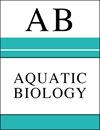Novel, complex burrow structure and burrowing behaviour of the mud-dwelling octopus (Octopus minor, Sasaki 1920)
IF 0.8
4区 生物学
Q3 MARINE & FRESHWATER BIOLOGY
引用次数: 0
Abstract
: The strategies employed by octopuses for predator avoidance and escape, which are adapted to their structurally simple habitat, have been the subject of much research. In the pres-ent study, the shapes and structural characteristics of Octopus minor’s burrows were investigated and the burrowing behavior was also observed to reveal the dynamics of burrow formation. From 2012 to 2017, 85 plasticized cement burrow models were measured. The burrow, a complex project, includes 7 interconnected structural parts: digging holes (DH), digging channel (DC), horizontal channel (HC), lounge (LG), breathing channel (BC), breathing holes (BH), and breathing hole heap (BHH), with each part having its own cross-sections of special shape and size. The diameters of all parts were very significantly different and had extremely significant correlations with other factors, except for the weight of the occupants. The burrows have 1−2 DHs, 1−4 BHs and 1 BHH, with DHs and BHs distributed at opposite ends of the burrow. The burrows were categorized into 7 types according to the number of DHs, and burrows with 2 BHs accounted for a distinct type. The diameters of LG, DC and HC and the occupants’ weight decreased as the number of BHs increased. The process of excavating a burrow involved 5 steps: creating a DH, inserting arms into the DH, burrowing, excavating the BC, and creating the LG. Abandoned burrows could be reoccupied by other octopuses, regardless of whether they were larger or smaller than the previous occupants. As an adaptation to structurally simple environment, O. minor seems to use a particular skill in digging more complex burrows as shelters.新奇、复杂的穴居章鱼的洞穴结构和穴居行为(octopus minor, Sasaki 1920)
本文章由计算机程序翻译,如有差异,请以英文原文为准。
求助全文
约1分钟内获得全文
求助全文
来源期刊

Aquatic Biology
生物-海洋与淡水生物学
CiteScore
2.70
自引率
0.00%
发文量
7
审稿时长
3 months
期刊介绍:
AB publishes rigorously refereed and carefully selected Feature Articles, Research Articles, Reviews and Notes, as well as Comments/Reply Comments (for details see MEPS 228:1), Theme Sections, Opinion Pieces (previously called ''As I See It'') (for details consult the Guidelines for Authors) concerned with the biology, physiology, biochemistry and genetics (including the ’omics‘) of all aquatic organisms under laboratory and field conditions, and at all levels of organisation and investigation. Areas covered include:
-Biological aspects of biota: Evolution and speciation; life histories; biodiversity, biogeography and phylogeography; population genetics; biological connectedness between marine and freshwater biota; paleobiology of aquatic environments; invasive species.
-Biochemical and physiological aspects of aquatic life; synthesis and conversion of organic matter (mechanisms of auto- and heterotrophy, digestion, respiration, nutrition); thermo-, ion, osmo- and volume-regulation; stress and stress resistance; metabolism and energy budgets; non-genetic and genetic adaptation.
-Species interactions: Environment–organism and organism–organism interrelationships; predation: defenses (physical and chemical); symbioses.
-Molecular biology of aquatic life.
-Behavior: Orientation in space and time; migrations; feeding and reproductive behavior; agonistic behavior.
-Toxicology and water-quality effects on organisms; anthropogenic impacts on aquatic biota (e.g. pollution, fisheries); stream regulation and restoration.
-Theoretical biology: mathematical modelling of biological processes and species interactions.
-Methodology and equipment employed in aquatic biological research; underwater exploration and experimentation.
-Exploitation of aquatic biota: Fisheries; cultivation of aquatic organisms: use, management, protection and conservation of living aquatic resources.
-Reproduction and development in marine, brackish and freshwater organisms
 求助内容:
求助内容: 应助结果提醒方式:
应助结果提醒方式:


